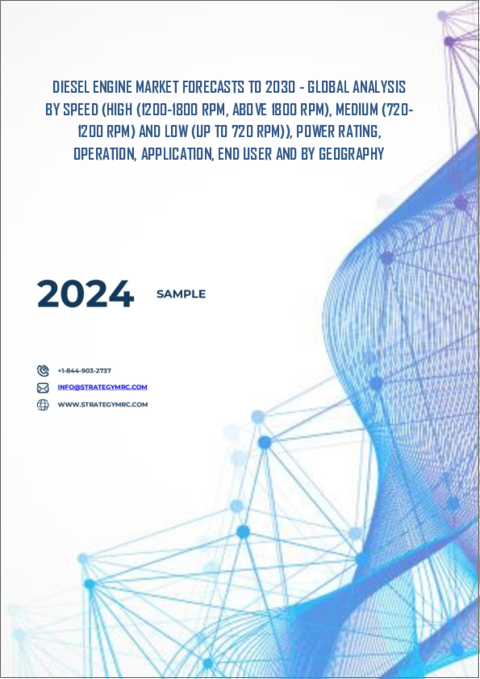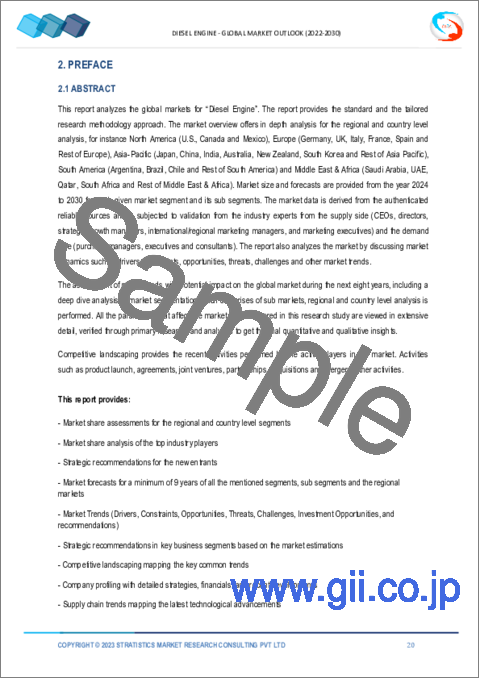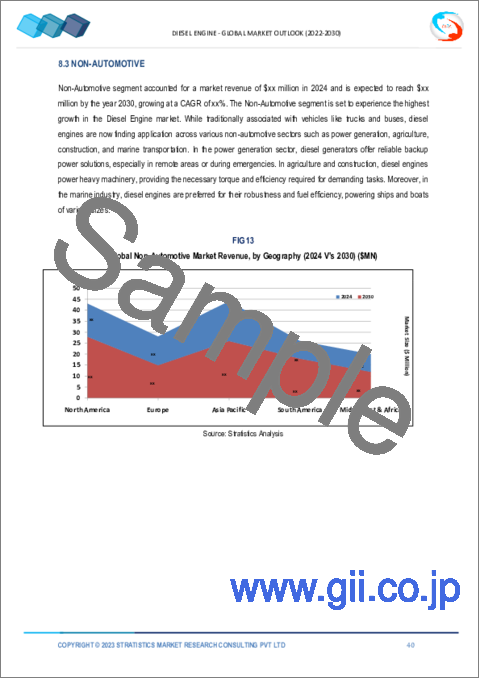|
|
市場調査レポート
商品コード
1339916
ディーゼルエンジン市場の2030年までの予測- 回転数別、定格出力別、オペレーション別、用途別、エンドユーザー別、地域別の世界分析Diesel Engine Market Forecasts to 2030 - Global Analysis By Speed (High (1200-1800 rpm, Above 1800 rpm), Medium (720-1200 rpm) and Low (Up to 720 rpm)), Power Rating, Operation, Application, End User and By Geography |
||||||
カスタマイズ可能
|
|||||||
| ディーゼルエンジン市場の2030年までの予測- 回転数別、定格出力別、オペレーション別、用途別、エンドユーザー別、地域別の世界分析 |
|
出版日: 2023年08月01日
発行: Stratistics Market Research Consulting
ページ情報: 英文 175+ Pages
納期: 2~3営業日
|
- 全表示
- 概要
- 図表
- 目次
Stratistics MRCによると、世界のディーゼルエンジン市場は2023年に639億米ドルを占め、予測期間中のCAGRは6.3%で成長し、2030年には981億米ドルに達すると予測されています。
内燃機関であるディーゼルエンジンは、円筒容器内の空気を圧縮して燃料に点火し、化学エネルギーを機械エネルギーに変換します。大型船舶、機関車、貨物トラックはすべてこのエネルギー源を動力源としています。ディーゼルエンジンは、その高い運転性能と燃費効率により、エンドユーザーからますます支持されるようになっています。ディーゼルエンジンは、小型発電機から巨大な船舶まで、さまざまな動力と性能のニーズを満たすように設計されるため、適応性と汎用性が高いです。ディーゼルエンジンは、その汎用性の高さから、さまざまな用途で人気の高い選択肢となっています。
EIAのInternational Energy Outlook 2019によると、世界のエネルギー需要は2040年まで毎年2.11%増加すると予想されています。World Energy Outlookによると、サハラ以南のアフリカでは電化率は35%だが、農村部の電化率は19%に過ぎず、5億5,000万人が電気を利用できない状態にあります。
市場力学:
自動車産業の拡大
自動車産業の拡大は、市場成長を促進する主要な要因のひとつです。ディーゼルエンジンは、ガソリン・エンジンよりも燃費がよく、汚染物質が少なく、出力が高いなど、さまざまな利点があるため、高い需要があります。自動車の需要が増加するにつれて、ディーゼルエンジンの需要も増加します。この増加には、経済発展、都市化の拡大、個人的な移動手段に対する消費者の嗜好の高まりなど、さまざまな変数が関わっています。
代替エネルギー源の利用可能性
代替発電・貯蔵技術には、SOFCセル、太陽光発電、再生可能エネルギー、バッテリー、燃料電池などがあり、多くの先進国で利用されています。さらに、太陽光や風力のような再生可能エネルギー源の成長は、単位当たりのエネルギー生産価格を引き下げています。再生可能エネルギー源に比べ、ディーゼル発電のコストは2~3倍高いです。その結果、この要因が市場の拡大を妨げています。
ハイブリッド発電の増加
必要な電力は、ハイブリッド発電によって、電信塔、遠隔地の工業用地、小さな集落、島など、オフグリッドや遠隔地に送ることができます。オフグリッド地域の大部分は、電気が普及していない発展途上国にあります。そのような遠隔地のエネルギー需要は、ディーゼル発電機と再生可能エネルギー源を組み合わせたハイブリッド発電システムによって満たされています。その結果、これが市場拡大を牽引する主な要素となっています。
燃料費の高騰
ディーゼル燃料は、ガソリンやその他の代替燃料に比べて高価であり、特に長時間の活動には不向きです。潤滑、冷却、給油、始動用バッテリー、燃料フィルターの定期的な整備と給油は、予防保守のために必要です。これらの費用は、再生可能技術の運転コストよりも大きく、ディーゼルエンジンの全体的な運転・維持コストに上乗せされます。燃料価格の高騰とディーゼルエンジンの運転・保守費用が、このセグメントの成長を妨げる要因となっています。
COVID-19の影響
ディーゼルエンジンの売上は、COVID-19の発生によりマイナスの影響を受けた。このパンデミックは、主に海運業界における混乱により、サプライチェーンの崩壊を引き起こし、ディーゼルエンジンの生産からその配送に必要な輸送まですべてに影響を及ぼしました。商業および産業インフラの発展と自給自足の電力需要により、ディーゼルエンジン市場の拡大と促進されています。
予測期間中、スタンバイ・セグメントが最大になる見込み
予測期間中、スタンバイ・セグメントが最大となる見込みです。非常用電源は通常、スタンバイ・ディーゼルエンジンによって供給されます。消費者は、送電網が停止した場合に需要を満たすために、一時的にディーゼル発電機に頼ることができます。スタンバイ・ディーゼルエンジンは、迅速な始動、ディーゼルエンジンを動力源とする発電機の低い始動コスト、商業的に実行可能な重要な代替品の欠如などの特質により、他のタイプの中で最も好ましい選択肢です。
予測期間中にCAGRが最も高くなると予想される産業用セグメント
産業用セグメントは、これらのエンドユーザーからの安定した信頼性の高い電力供給に対する需要が高まっているため、予測期間中に最も高いCAGRが見込まれます。ディーゼル発電は、産業部門のスタンバイ電源として最も適しています。一般に、産業部門は事業運営のために多くの電力を消費します。ディーゼル発電エンジンは、より優れた信頼性を提供し、電力供給の質を高める。
最大のシェアを占める地域
アジア太平洋地域は、インフラ整備と電力需要の増加により、予測期間中最大の市場シェアを占めると予測されます。生活水準の向上、都市化、人口の拡大などが、この地域での市場拡大の要因となっています。電力消費量の大幅な増加により、電力インフラが脆弱な途上国では、電力の安定供給を確保するのが困難になると予想されます。
CAGRが最も高い地域:
予測期間中、欧州が最も高いCAGRを維持すると予測されます。市場成長は、建設、自動車、電力・ガスなど、さまざまな応用分野での普及率の上昇によってさらに影響を受けると予想されます。さらに、世界中の政府がディーゼルエンジンからの排出ガスを削減するための規制を設けているため、メーカーはディーゼルエンジンの開発を試みています。
無料カスタマイズサービス:
本レポートをご購読のお客様には、以下のいずれかの無料カスタマイズオプションをご提供いたします:
- 企業プロファイル
- 追加市場プレイヤーの包括的プロファイリング(3社まで)
- 主要企業のSWOT分析(3社まで)
- 地域セグメンテーション
- 顧客の関心に応じた主要国の市場推計・予測・CAGR(注:フィージビリティチェックによる)
- 競合ベンチマーキング
- 製品ポートフォリオ、地理的プレゼンス、戦略的提携に基づく主要企業のベンチマーキング
目次
第1章 エグゼクティブサマリー
第2章 序文
- エグゼクティブサマリー
- ステークホルダー
- 調査範囲
- 調査手法
- データマイニング
- データ分析
- データ検証
- 調査アプローチ
- 調査ソース
- 一次調査情報源
- 二次調査情報源
- 前提条件
第3章 市場動向分析
- 促進要因
- 抑制要因
- 機会
- 脅威
- アプリケーション分析
- エンドユーザー分析
- 新興市場
- COVID-19の影響
第4章 ポーターのファイブフォース分析
- 供給企業の交渉力
- 買い手の交渉力
- 代替品の脅威
- 新規参入業者の脅威
- 競争企業間の敵対関係
第5章 ディーゼルエンジンの世界市場:回転数別
- 高回転(1200-1800rpm、1800rpm以上)
- 中速(720-1200rpm)
- 低速(720rpmまで)
第6章 ディーゼルエンジンの世界市場:定格出力別
- 5.0MW以上
- 2.1-5.0 MW
- 1.1-2.0 MW
- 0.5-1.0 MW
- 0.5MW未満
第7章 ディーゼルエンジンの世界市場:オペレーション別
- プライム
- スタンバイ
- ピークカット
第8章 ディーゼルエンジンの世界市場:用途別
- 自動車
- オフロード
- 農業機械
- 船舶用
- 建設機械
- オンロード
- 小型トラック
- 中型/大型トラック
- 軽自動車
- オフロード
- 自動車以外
- その他の用途
第9章 ディーゼルエンジンの世界市場:エンドユーザー別
- 商業用
- 産業用
- 住宅用
- その他のエンドユーザー
第10章 ディーゼルエンジンの世界市場:地域別
- 北米
- 米国
- カナダ
- メキシコ
- 欧州
- ドイツ
- 英国
- イタリア
- フランス
- スペイン
- その他欧州
- アジア太平洋
- 日本
- 中国
- インド
- オーストラリア
- ニュージーランド
- 韓国
- その他アジア太平洋地域
- 南米
- アルゼンチン
- ブラジル
- チリ
- その他南米
- 中東・アフリカ
- サウジアラビア
- アラブ首長国連邦
- カタール
- 南アフリカ
- その他中東とアフリカ
第11章 主な発展
- 契約、パートナーシップ、提携、合弁事業
- 買収と合併
- 新製品の上市
- 事業拡大
- その他の主要戦略
第12章 企業プロファイル
- Hyundai Heavy Industries Co. Ltd
- Cummins Inc.
- Doosan Corp.
- Kohler Co
- Deere & Company
- Caterpillar Inc.
- Man SE
- Mitsubishi Heavy Industries Ltd
- Wartsila Oyj Abp
- Ford Motor Company
- Rolls-Royce Holding PLC
- General Motors Company
- Delphi Automotive System Private Limited
- AGCO Corporation
- Continental AG
- Yanmar Co., Ltd.
- Kubota Corporation
List of Tables
- Table 1 Global Diesel Engine Market Outlook, By Region (2021-2030) ($MN)
- Table 2 Global Diesel Engine Market Outlook, By Speed (2021-2030) ($MN)
- Table 3 Global Diesel Engine Market Outlook, By High (1200-1800 rpm, Above 1800 rpm) (2021-2030) ($MN)
- Table 4 Global Diesel Engine Market Outlook, By Medium (720-1200 rpm) (2021-2030) ($MN)
- Table 5 Global Diesel Engine Market Outlook, By Low (Up to 720 rpm) (2021-2030) ($MN)
- Table 6 Global Diesel Engine Market Outlook, By Power Rating (2021-2030) ($MN)
- Table 7 Global Diesel Engine Market Outlook, By Above 5.0 MW (2021-2030) ($MN)
- Table 8 Global Diesel Engine Market Outlook, By 2.1-5.0 MW (2021-2030) ($MN)
- Table 9 Global Diesel Engine Market Outlook, By 1.1-2.0 MW (2021-2030) ($MN)
- Table 10 Global Diesel Engine Market Outlook, By 0.5-1.0 MW (2021-2030) ($MN)
- Table 11 Global Diesel Engine Market Outlook, By Below 0.5 MW (2021-2030) ($MN)
- Table 12 Global Diesel Engine Market Outlook, By Operation (2021-2030) ($MN)
- Table 13 Global Diesel Engine Market Outlook, By Prime (2021-2030) ($MN)
- Table 14 Global Diesel Engine Market Outlook, By Standby (2021-2030) ($MN)
- Table 15 Global Diesel Engine Market Outlook, By Peak Shaving (2021-2030) ($MN)
- Table 16 Global Diesel Engine Market Outlook, By Application (2021-2030) ($MN)
- Table 17 Global Diesel Engine Market Outlook, By Automotive (2021-2030) ($MN)
- Table 18 Global Diesel Engine Market Outlook, By Off-Road (2021-2030) ($MN)
- Table 19 Global Diesel Engine Market Outlook, By Agriculture Equipment (2021-2030) ($MN)
- Table 20 Global Diesel Engine Market Outlook, By Marine Applications (2021-2030) ($MN)
- Table 21 Global Diesel Engine Market Outlook, By Construction Equipment (2021-2030) ($MN)
- Table 22 Global Diesel Engine Market Outlook, By On-Road (2021-2030) ($MN)
- Table 23 Global Diesel Engine Market Outlook, By Light Trucks (2021-2030) ($MN)
- Table 24 Global Diesel Engine Market Outlook, By Medium/Heavy Trucks (2021-2030) ($MN)
- Table 25 Global Diesel Engine Market Outlook, By Light Vehicles (2021-2030) ($MN)
- Table 26 Global Diesel Engine Market Outlook, By Non-Automotive (2021-2030) ($MN)
- Table 27 Global Diesel Engine Market Outlook, By Other Applications (2021-2030) ($MN)
- Table 28 Global Diesel Engine Market Outlook, By End User (2021-2030) ($MN)
- Table 29 Global Diesel Engine Market Outlook, By Commercial (2021-2030) ($MN)
- Table 30 Global Diesel Engine Market Outlook, By Industrial (2021-2030) ($MN)
- Table 31 Global Diesel Engine Market Outlook, By Residential (2021-2030) ($MN)
- Table 32 Global Diesel Engine Market Outlook, By Other End Users (2021-2030) ($MN)
Note: Tables for North America, Europe, APAC, South America, and Middle East & Africa Regions are also represented in the same manner as above.
According to Stratistics MRC, the Global Diesel Engine Market is accounted for $63.9 billion in 2023 and is expected to reach $98.1 billion by 2030 growing at a CAGR of 6.3% during the forecast period. An internal combustion engine, the diesel engine compresses the air inside a cylindrical vessel to ignite the fuel, transforming chemical energy into mechanical energy. Large ships, locomotives and goods trucks are all powered by this energy source. Diesel engines are increasingly favoured by end users due to their higher operational performance and fuel efficiency. Diesel engines may be constructed to satisfy a variety of power and performance needs, from small generators to massive marine vessels, making them adaptable and versatile as well. They are a popular option for a variety of applications because of their versatility.
According to the EIA's International Energy Outlook 2019, global energy demand is anticipated to rise by 2.11% annually until 2040. According to World Energy Outlook, in Sub-Saharan Africa, the electrification rate is 35%, but only 19% of the rural areas are electrified, leaving 550 million people without access to electricity.
Market Dynamics:
Driver:
Expansion of the automotive industry
The expansion of the automobile industry is one of the primary drivers driving market growth. Diesel engines are in high demand because they have various benefits over petrol engines, including better fuel efficiency, reduced pollutants, and higher power output. As the demand for automobiles rises, so does the demand for diesel engines. This increase has been fueled by a variety of variables, including as economic development, expanding urbanisation, and rising consumer preference for personal transportation.
Restraint:
The availability of alternative sources of energy
Alternative power generating and storage technologies include SOFC cells, solar PVs, renewable energy, batteries, and fuel cells in many industrialised countries. Additionally, the growth of renewable energy sources like solar and wind has reduced the price of energy production per unit. Compared to renewable energy sources, the cost of producing diesel power is two to three times higher. Consequently, this factor is impeding market expansion.
Opportunity:
Increasing the production of hybrid electricity
The required electricity can be sent to off-the-grid or remote locations, such as telecom towers, remote industrial sites, tiny settlements, islands, and more via hybrid power generation. The majority of the off-grid areas are found in developing countries where electricity is not commonplace. Such remote locations' energy requirements are met by hybrid power systems that combine diesel generators and renewable energy sources. As a result, this is the main element driving the market's expansion.
Threat:
High fuel costs
Diesel fuel is more expensive than substitutes like petrol and other fuels, especially for longer-duration activities. Regular servicing and refuelling of the lubrication, cooling, fueling, starting batteries, and fuel filters are necessary for preventive maintenance. These expenses are greater than the operating costs of renewable technologies and add up to the overall operating and maintenance costs of diesel engines. High fuel prices as well as the operating and maintenance expenses of diesel engines are the factors hampering the segment growth.
COVID-19 Impact:
Diesel engine sales were negatively impacted by the COVID-19 outbreak. Due to disruptions mostly in the shipping industry, the pandemic caused the supply chain to break down, affecting everything from the production of diesel engines to the transportation required for their delivery. The developments of commercial and industrial infrastructures as well as the requirement for dependable electricity are driving the market for diesel power engines in terms of market expansion.
The standby segment is expected to be the largest during the forecast period
The standby segment is expected to be the largest during the forecast period. Emergency power supplies are typically provided by standby diesel engines. The consumer can temporarily rely on diesel-powered generators to meet demand in the case of a grid outage. Standby diesel engines are the most preferable option among the other types due to their qualities, including quick starting, low starting costs for generators powered by diesel engines, and the lack of significant commercially viable alternatives.
The industrial segment is expected to have the highest CAGR during the forecast period
The industrial segment is expected to have the highest CAGR during the forecast period, due to growing demand for constant and reliable power supply from these end-users. Diesel power generation is most appropriate as a standby source for the industrial sector. Generally, the industrial sector consumes more power for its business operations. A diesel power engine offers better reliability and enhances the quality of the power supply.
Region with largest share:
Asia Pacific is projected to hold the largest market share during the forecast period, owing to increasing infrastructural developments and electricity demand. The rising level of life, urbanisation, and expanding population are all factors contributing to the market's expansion in the area. Due to their massive increase in power consumption, developing countries with weak power infrastructure are expected to have a difficult time ensuring a steady supply of electricity.
Region with highest CAGR:
Europe is projected to hold the highest CAGR over the forecast period. The market growth is anticipated to be further impacted by rising penetration across a variety of application sectors, such as construction, cars, electricity & gas, etc. Additionally, governments all over the world have put restrictions in place to reduce the emissions from diesel engines, which has prompted manufacturers to experiment with the development of diesel engines.
Key players in the market:
Some of the key players in Diesel Engine market include: Hyundai Heavy Industries Co. Ltd, Cummins Inc., Doosan Corp., Kohler Co, Deere & Company, Caterpillar Inc., Man SE, Mitsubishi Heavy Industries Ltd, Wartsila Oyj Abp, Ford Motor Company, Rolls-Royce Holding PLC, General Motors Company, Delphi Automotive System Private Limited, AGCO Corporation, Continental AG, Yanmar Co., Ltd. and Kubota Corporation.
Key Developments:
- In March 2023, Caterpillar announced the development of the CAT C13D, a new 13-liter diesel engine platform designed to achieve best-in-class power density, torque, and fuel efficiency for optimizing the performance of heavy-duty off-highway applications.
- In June 2022, WinGD and Hyundai announced partner on development of ammonia engine. Winterthur Gas and Diesel (WinGD) collaborated with the Engine Machinery Division (EMD) of Hyundai Heavy Industries (HHI) to develop a two-stroke engine that can run using ammonia.
- In January 2022, Caterpillar company announced the launch of a new line of drop-in engines. Caterpillar had introduced a range of drop-in engines that are ready to use right out of the box due to their easy installation, and reliable and robust construction.
Speeds Covered:
- High (1200-1800 rpm, Above 1800 rpm)
- Medium (720-1200 rpm)
- Low (Up to 720 rpm)
Power Ratings Covered:
- Above 5.0 MW
- 2.1-5.0 MW
- 1.1-2.0 MW
- 0.5-1.0 MW
- Below 0.5 MW
Operations Covered:
- Prime
- Standby
- Peak Shaving
Processing Types Covered:
- Edge Computing
- Cloud Computing
Applications Covered:
- Automotive
- Non-Automotive
- Other Applications
End Users Covered:
- Commercial
- Industrial
- Residential
- Other End Users
Regions Covered:
- North America
- US
- Canada
- Mexico
- Europe
- Germany
- UK
- Italy
- France
- Spain
- Rest of Europe
- Asia Pacific
- Japan
- China
- India
- Australia
- New Zealand
- South Korea
- Rest of Asia Pacific
- South America
- Argentina
- Brazil
- Chile
- Rest of South America
- Middle East & Africa
- Saudi Arabia
- UAE
- Qatar
- South Africa
- Rest of Middle East & Africa
What our report offers:
- Market share assessments for the regional and country-level segments
- Strategic recommendations for the new entrants
- Covers Market data for the years 2021, 2022, 2023, 2026, and 2030
- Market Trends (Drivers, Constraints, Opportunities, Threats, Challenges, Investment Opportunities, and recommendations)
- Strategic recommendations in key business segments based on the market estimations
- Competitive landscaping mapping the key common trends
- Company profiling with detailed strategies, financials, and recent developments
- Supply chain trends mapping the latest technological advancements
Free Customization Offerings:
All the customers of this report will be entitled to receive one of the following free customization options:
- Company Profiling
- Comprehensive profiling of additional market players (up to 3)
- SWOT Analysis of key players (up to 3)
- Regional Segmentation
- Market estimations, Forecasts and CAGR of any prominent country as per the client's interest (Note: Depends on feasibility check)
- Competitive Benchmarking
- Benchmarking of key players based on product portfolio, geographical presence, and strategic alliances
Table of Contents
1 Executive Summary
2 Preface
- 2.1 Abstract
- 2.2 Stake Holders
- 2.3 Research Scope
- 2.4 Research Methodology
- 2.4.1 Data Mining
- 2.4.2 Data Analysis
- 2.4.3 Data Validation
- 2.4.4 Research Approach
- 2.5 Research Sources
- 2.5.1 Primary Research Sources
- 2.5.2 Secondary Research Sources
- 2.5.3 Assumptions
3 Market Trend Analysis
- 3.1 Introduction
- 3.2 Drivers
- 3.3 Restraints
- 3.4 Opportunities
- 3.5 Threats
- 3.6 Application Analysis
- 3.7 End User Analysis
- 3.8 Emerging Markets
- 3.9 Impact of Covid-19
4 Porters Five Force Analysis
- 4.1 Bargaining power of suppliers
- 4.2 Bargaining power of buyers
- 4.3 Threat of substitutes
- 4.4 Threat of new entrants
- 4.5 Competitive rivalry
5 Global Diesel Engine Market, By Speed
- 5.1 Introduction
- 5.2 High (1200-1800 rpm, Above 1800 rpm)
- 5.3 Medium (720-1200 rpm)
- 5.4 Low (Up to 720 rpm)
6 Global Diesel Engine Market, By Power Rating
- 6.1 Introduction
- 6.2 Above 5.0 MW
- 6.3 2.1-5.0 MW
- 6.4 1.1-2.0 MW
- 6.5 0.5-1.0 MW
- 6.6 Below 0.5 MW
7 Global Diesel Engine Market, By Operation
- 7.1 Introduction
- 7.2 Prime
- 7.3 Standby
- 7.4 Peak Shaving
8 Global Diesel Engine Market, By Application
- 8.1 Introduction
- 8.2 Automotive
- 8.2.1 Off-Road
- 8.2.1.1 Agriculture Equipment
- 8.2.1.2 Marine Applications
- 8.2.1.2 Construction Equipment
- 8.2.1 On-Road
- 8.2.2.1 Light Trucks
- 8.2.2.2 Medium/Heavy Trucks
- 8.2.2.3 Light Vehicles
- 8.2.1 Off-Road
- 8.3 Non-Automotive
- 8.4 Other Applications
9 Global Diesel Engine Market, By End User
- 9.1 Introduction
- 9.2 Commercial
- 9.3 Industrial
- 9.4 Residential
- 9.5 Other End Users
10 Global Diesel Engine Market, By Geography
- 10.1 Introduction
- 10.2 North America
- 10.2.1 US
- 10.2.2 Canada
- 10.2.3 Mexico
- 10.3 Europe
- 10.3.1 Germany
- 10.3.2 UK
- 10.3.3 Italy
- 10.3.4 France
- 10.3.5 Spain
- 10.3.6 Rest of Europe
- 10.4 Asia Pacific
- 10.4.1 Japan
- 10.4.2 China
- 10.4.3 India
- 10.4.4 Australia
- 10.4.5 New Zealand
- 10.4.6 South Korea
- 10.4.7 Rest of Asia Pacific
- 10.5 South America
- 10.5.1 Argentina
- 10.5.2 Brazil
- 10.5.3 Chile
- 10.5.4 Rest of South America
- 10.6 Middle East & Africa
- 10.6.1 Saudi Arabia
- 10.6.2 UAE
- 10.6.3 Qatar
- 10.6.4 South Africa
- 10.6.5 Rest of Middle East & Africa
11 Key Developments
- 11.1 Agreements, Partnerships, Collaborations and Joint Ventures
- 11.2 Acquisitions & Mergers
- 11.3 New Product Launch
- 11.4 Expansions
- 11.5 Other Key Strategies
12 Company Profiling
- 12.1 Hyundai Heavy Industries Co. Ltd
- 12.2 Cummins Inc.
- 12.3 Doosan Corp.
- 12.4 Kohler Co
- 12.5 Deere & Company
- 12.6 Caterpillar Inc.
- 12.7 Man SE
- 12.8 Mitsubishi Heavy Industries Ltd
- 12.9 Wartsila Oyj Abp
- 12.10 Ford Motor Company
- 12.11 Rolls-Royce Holding PLC
- 12.12 General Motors Company
- 12.13 Delphi Automotive System Private Limited
- 12.14 AGCO Corporation
- 12.15 Continental AG
- 12.16 Yanmar Co., Ltd.
- 12.17 Kubota Corporation






